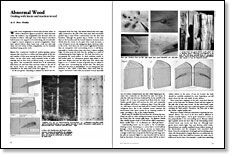
Synopsis: Renowned wood technologist R. Bruce Hoadley describes some features that seem to be negative in woodworking, but the reader is urged to reserve judgment on nature’s “irregularities,” as he describes them. He talks about how to identify, predict, and cope with blemishes such as knots and juvenile and reaction wood, as well as multiple subcategories within each. Detailed photos show examples of the defects he’s describing.
From Fine Woodworking #26
While some irregularities in wood may increase value, as when a distinctive figure is produced, others decrease value. By tradition, any irregularities that decrease value are branded as defects. Although some of the features described below seem to be negative in woodworking, the woodworker is urged to reserve judgment on nature’s irregularities. These were indeed defects when hand tools could not deal with them, but now many of these irregularities can be routinely machined using power tools.
Knots—The commercial hardwood lumber-grading system assumes that every knot is a defect and bases grade on the size and number of clear areas among the knots (and other blemishes). On the other hand, many beautiful works of craftsmanship and art have been produced using, or even featuring, knots. The woodworker should first of all understand what knots are and how their structure relates to the rest of the wood. Knots are simply the parts of limbs that are embedded in the main stem of the tree.
As the tree grows, branching is initiated by lateral bud development from the twig. The lateral branch thus was originally connected to the pith of the main stem. Each successive growth ring or layer forms continuously over the stem and branches, although the growth ring is thicker on the stem than on the branches and the branch diameter increases more slowly than the trunk. As the girth of the trunk increases, a cone of branch wood—the intergrown knot—develops within the trunk. Such knots are also termed tight knots because they are intergrown with surrounding wood, or red knots, especially in conifers where they often have a distinct reddish tinge. At some point the limb may die, perhaps as a result of overshadowing by limbs higher up. The limb dies back to approximately the trunk surface, its dead cambium unable to add further girth. So subsequent growth rings added to the main stem simply surround the dead limb stub, which may begin to rot. A number of years of growth may be added to the main stem, surrounding the branch stub. The dead part of the stub becomes an encased knot. It is not intergrown and therefore is also called a loose knot, often with bark entrapped.
For the full article, download the PDF below:
Fine Woodworking Recommended Products

AnchorSeal Log and Lumber End-Grain Sealer

DeWalt 735X Planer

Ridgid R4331 Planer





















Log in or create an account to post a comment.
Sign up Log in